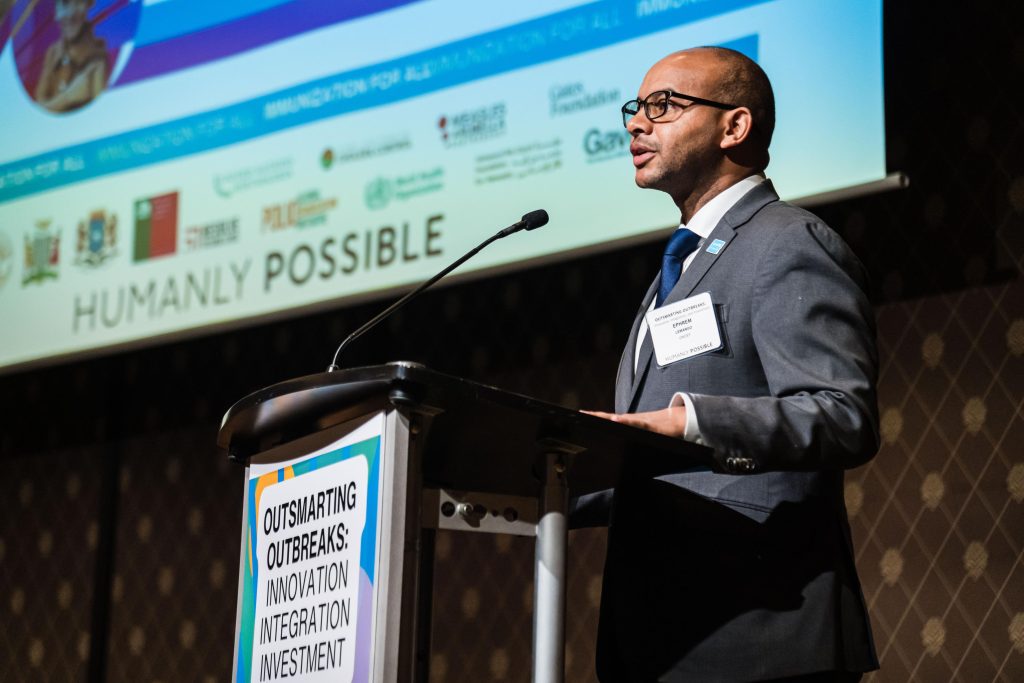M&RP was a co-host of a 78th World Health Assembly side event titled: Outsmarting Outbreaks: Innovation, Integration, and Investment. The event brought together more than 250 global health leaders for a powerful and timely conversation on how to protect progress, scale solutions, and finish the job of eliminating polio, measles, cholera, and other vaccine-preventable diseases making an alarming resurgence.
All of this is happening at a time when the world has seen the worst continued backsliding in global immunization coverage in 30 years, largely on account of the COVID-19 pandemic and related disruptions. UNICEF’s Chief of Immunization Dr. Ephrem Lemango kicked off the two-part discussion with a clear call-to-action: now is not a moment to retreat, but to recommit—to innovation, integration, and investment in immunization.
In part one, President and CEO of Resolve to Save Lives Dr. Tom Frieden moderated “Breaking the Cycle: Rebuilding the Foundations of Outbreak Prevention,” which emphasized primary health care and routine immunization as the foundation of outbreak prevention. His Excellency Dr. Ali Haji Adam Abubakar, minister of health of Somalia described how his country is balancing emergency response with investments in sustainable systems, and His Excellency Dr. Samuel Roger Kamba, minister of health for the Democratic Republic of the Congo, emphasized the importance of maintaining strong and functional primary healthcare systems.

Director of Immunization at the World Health Organization Dr. Katherine O’Brien urged global health leaders to “double down on what works” and confront threats that risk reversing hard-won gains head-on. “This is fundamentally about breakdowns of systems. It’s about coverage falling, it’s about surveillance that is far overstretched, and overreliance on vertical responses and single donors.”
Dr. O’Brien touted promising innovations like the multi-array patch, which allows vaccines to be deployed without an injection or a need for continuous cold chain storage. “[This is] expected to be a game-changer in who can be a vaccinator, and how far that reach can go outside the cold chain and change the trajectory of measles.”
“[Whatever approach we take must be organized] around a shared strategy, coordinated action, and sustained country support and action,” she concluded.
In part two, Dr. Cecilia Mundaca Shah (UN Foundation) moderated “From Data to Action,” in which countries explained how they are operationalizing integrated surveillance to enable faster, smarter outbreak detection and response. Examples included Zambia’s use of genomic and wastewater surveillance to proactively detect threats, and Germany’s support to the WHO Hub in Berlin as a model of cross-border collaboration in epidemic intelligence. Finally, Sara Hersey of WHO’s Health Emergencies Programme emphasized collaboration with countries as the most important innovation.
“It’s not about the data collection itself, which is critical, but it’s about how we translate that information into public health action,” said Hersey. “The innovation is in very deliberately building partnerships, networks and collaborations in this space. I think we all realize with COVID-19, no single country has all the answers, no single partner, no single donor. We need to have collective answers, together.”
The discussion culminated in one powerful closing moment when the Government of Madagascar declared an official elimination of the type 1 poliovirus in Madagascar—an inspiring real-time testament to what’s possible through collaboration, community mobilization, and strong surveillance systems.

In the end, the forum underscored that immunization, integrated surveillance, and primary care are not standalone efforts, but rather the backbone of global health security. Our best defense against future threats is investing in the tools, systems, leadership, and partnership to lock in progress, eradicate vaccine-preventable disease, and outsmart future outbreaks—together.



















 Prelude Version 2.3.2
Prelude Version 2.3.2